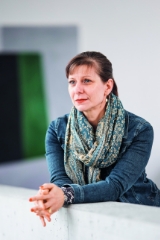History
“A society can be seen in its shelters”
What do Swiss women, Kim Kardashian and Donald Trump have in common? A bunker as a sanctuary. But is the underground really suitable for crisis management? A conversation with history professor Silvia Berger about the past and future of a Swiss symbolic site.

Silvia Berger: Bunkers and bacteria have, at least at first glance, a simple structure – both are unicellular organisms, as it were. And yet both have deeply engraved themselves into the collective consciousness of the people. Bunkers and germs are associated with massive fears and often invisible threats that potentially affect all of humanity, such as pandemics or nuclear war.
“The purpose of the bunker was to educate docile citizens and freeze social change, so to speak.”
Silvia Berger Ziauddin
Both ask questions about death and life as well as how the state and expertise can cope with states of emergency. They also ask questions about solidarity, cohesion and social differences during periods of shock: Who has space in the bunker, who has access to vaccines? Bacteria as well as bunkers shape our perception of disasters. They are not as simple as they appear on the surface, but rather leave a deep imprint on our society.
This “imprint” seems to be particularly pronounced in Switzerland. Hardly any other country in the world has as many bunkers as we do here, namely – as of today – around 370,000. Why?One reason was the strong legacy of the Second World War. In the interpretation of the military and politics, it was thanks to the military’s will to defend itself and the Réduit, the Alpine fortress, that Switzerland was not attacked by the Nazis. When a full-out war with nuclear weapons seemed possible with the looming East-West conflict, civil protection was also expanded in the spirit of “total national defense”. It was geared towards subterranean shelters which, like the Alpenréduit, were thought to have a deterrent effect. At the same time, the shelters became more and more a mythical retreat for Switzerland. The bunker was seen as a citizen’s retreat, a resistance cell and survival island for the family that, as the democratic essence of Switzerland, was to survive the nuclear war.
So the bunker is seen as more than just security and protection in Switzerland?That's right, actually, it represents a lot more. On the one hand, the bunker represents technocratic expertise that makes complex threats such as nuclear weapons seemingly calculable and manageable. It also functioned as a kind of state territory in miniature format. This is where docile citizens were to be educated and social change frozen, so to speak. This becomes particularly clear with regard to the bourgeois-patriarchal gender order. However, underground protective facilities also became a projection surface for resistance when creative artists, young leftists and punks appropriated the bunker from the 1970s onwards. A society can be seen in its shelters.
Subscribe to the uniAKTUELL newsletter

Discover stories about the research at the University of Bern and the people behind it.
On civil defense materials from the 1960s, for example, you will often find binary images: at the top, the catastrophe and the destruction. At the bottom, the neat concrete cell housing a small family consisting of father, mother and children: the bunker in a detached house as a capsule of Switzerland’s survival. As the head of the family, the father guarantees contact with the outside world; he reads the newspaper or operates the radio. The wife provides food and looks after the children. The bourgeois-patriarchal gender order is reproduced in this way. Children’s drawings depicting the “small family in a bunker” illustrate how formative this order was.
But the bunker had more than just a meaningful function. Swiss civil defense expertise was also an export commodity.That's right. From the 1970s, when the residential construction boom collapsed, Swiss engineering and protective construction technology companies looked for sales markets abroad. They were in competition with companies from West Germany, Sweden and Finland. The Swiss involvement in bunker projects in the Middle East, for example in Iraq, has been made public by media reports since the turn of the millennium. Criticism was first voiced in Switzerland in the 1980s. Critics of civil defense argued that protection was just a facade, that Switzerland was in fact making an active contribution to war by exporting civil defense know-how and promoting the arms race. Historical studies on the exact extent of the international activities of Swiss companies have not yet been carried out. The protection periods of the relevant official files and the low willingness of the companies involved to provide information do not make this any easier.
Is Swiss shelter technology still exported today?For some time now, members of the globally growing prepper movement – from the English phrase “to be prepared” – have been equipping their Doomsday bunkers with Swiss-style ventilation systems. American companies are also installing Swiss-made explosion protection valves and armored doors in the prepper segment. The hardware used in Swiss protective structure research during the Cold War is being perpetuated at a global level in the new commercialized security rooms of the 21st century.
Bunkers are also being used in the canton of Bern to accommodate refugees. Are civil defense facilities suitable not only for protecting against external hazards, but also for locking up parts of society?The practice of accommodating refugees in civil defense facilities began at the end of the Cold War. Civil Defense was realigned and repurposing increased. In some cantons, the long-term placement of asylum seekers in civil defense shelters has become common practice. The “aux abris” exhibition in Lausanne recently took a critical look at this form of accommodation. It described the rooms as “management facilities for undesirables”. For the curators, the idea of a vertical evacuation of the Swiss population becomes a “vertical banishment”. In a documentary about refugees in Swiss bunkers, German broadcaster ARD asked whether such accommodation was really just an emergency solution or whether it was intended as a deterrent. The authorities must address these questions.
About the person

Silvia Berger Ziauddin
is Professor of Swiss and Modern General History at the University of Bern. Her research includes the history of Switzerland and the civil defense bunkers during the Cold War, the history of epidemics and the history of the underground since the 19th century.
Publication on the topic:
Berger Ziauddin, Silvia; Grob, Leo: “In die Tiefe. (Into the depths.) Geschichte und Zukünfte der Underground Frontier” (History and Future of the Underground Frontier), February 2024.
contact: silvia.berger@unibe.ch
When waves or floods are mentioned in the case of infectious diseases or migratory movements, these phenomena are characterized and placed in the register of threatening forces of nature. The consequence seems clear: If we fail to protect ourselves, this threat will sweep us away, blurring the inside and the outside. Tremors, in turn, evoke images of seismic activity: an instability of the subsurface, created without us having any part in it. However, climate change, biodiversity loss and COVID are not external phenomena attributable to nature, but genuinely linked to human action. For this reason, shock or tremor and the image of the wave should be reflected critically. The triggers are also naturalized and externalized. However, the term can also mean that seemingly stable certainties of a society are shaken, that a foundation is metaphorically shaken and new thought patterns are developed.
In response to challenges such as climate change, underground development also seems more topical than ever. The underground is described as the ultimate resource of the 21st century. What does that mean?It’s a promise made by today’s underground developers. Accordingly, the underground secures our future not only thanks to mineral raw materials, water and energy. It should also provide space for new transport and logistics projects, for waste storage, new safety and data, work and leisure spaces. Cities should grow upwards and also purposefully downwards. Projects such as the Lowline in New York promise a green habitat for the future where people live voluntarily, surrounded by plants and fed-in daylight. It’s about creating supposedly resilient, sustainable cities. Going into the depths as an easy-fix for above-ground problems associated with climate crisis, rapid urbanization and overpopulation.
It sounds like you’re skeptical about this underground euphoria.The question is, what is being concealed? It remains unclear to what extent the talk of sustainability is due to genuine concern for the environment. Switching downwards does not mean that production and consumption would be restricted above. In addition, subterranean construction is increasingly being carried out in the form of large-scale projects by private companies. Working conditions or participation rights in the underground are hardly discussed. This privatization of the underground makes it difficult to move towards a future in which the underground can be used in the public interest.
Magazine uniFOKUS

"Disruptions"
This article first appeared in uniFOKUS, the University of Bern print magazine. Four times a year, uniFOKUS focuses on one specialist area from different points of view. Current focus topic: "Disruptions"
More articles from this issue Subscribe to uniFOKUS magazineAs a historian, I can offer orientation knowledge, but not instructions for future action. I remain cautious when it comes to developing the underground, especially when it comes to its perception as an Eldorado and its exploitation. The question is not only what shocks and tremors the underground offers answers to, but also: Who is responsible for protecting the underground?
The nuclear bunker in Switzerland, on the other hand, is historically a response to a specific threat: nuclear war. It was not designed as a dynamically changeable space. We are currently living in an age of polycrises, in which moments of crisis can overlap and mutually potentiate one another. According to British historian Adam Tooze, this requires a constant willingness to change. Whether the nuclear safety space can adapt to the multiple crises of the 21st century is an open question. I do not in any way deny the legitimate need of the population for protection in the face of the current wars. But I think we need a debate: What dangers should and can the Swiss bunker offer protection against? How can our thinking remain open to change when it automatically, as an immediate reflex, focuses on the bunker under current and future shocks?